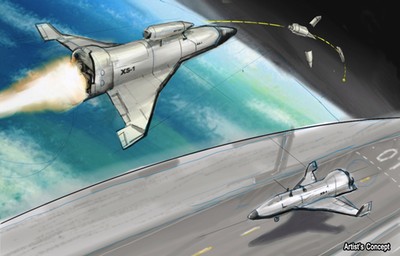The return of the X-vehicleby Jeff Foust
|
| “We’re not actually restricting the space to a winged or a non-winged vehicle,” Melroy said. “The key is that it needs to be a reusable first stage.” |
However, it turns out the government hasn’t yet given up on RLV X-vehicles. Last month, DARPA announced a new initiative called Experimental Spaceplane, or XS-1, that seeks to develop a reusable lower stage that, combined with an expendable upper stage, could place payloads weighing up to a couple thousand kilograms into low Earth orbit. XS-1, in DARPA’s vision, would be able to launch such payloads more frequently and less expensively than existing expendable launch vehicles.
The first public statements about XS-1 came out of the AIAA Space 2013 conference last month in San Diego. In a panel session about technology roadmaps at the conference September 12, Pam Melroy, a former astronaut who is now deputy director of DARPA’s Tactical Technology Office, said DARPA would soon start XS-1, developing it in parallel with the existing Airborne Launch Assist Space Access (ALASA) program, which is funding work on air-launch systems for launching small satellites.
“The goal there is to enable routine access for a larger payload class,” Melroy said of the XS-1 program. Specifically, she said XS-1 aimed to develop a vehicle that could fly ten times in ten days, flying to Mach 10 on at least one of those ten flights and deploying an upper stage for placing a payload into orbit. The cost per launch would also be no more than $5 million, about one-tenth the current cost of a Minotaur IV, which has a similar payload capacity as proposed for XS-1. In addition to being a reusable lower stage for launching satellite, she said XS-1 could also serve as a platform for hypersonics research.
In her presentation, Melroy showed various artists’ conceptions of XS-1, all of which had wings of some kind. However, she said the XS-1 program would not limit potential designs to vehicles that take off and land on runways. “We’re not actually restricting the space to a winged or a non-winged vehicle,” she said. “The key is that it needs to be a reusable first stage.”
Five days later, DARPA formally announced the XS-1 program, including plans to release a Broad Agency Announcement (BAA) in October to solicit technical concepts for the vehicle. “We want to build off of proven technologies to create a reliable, cost-effective space delivery system with one-day turnaround,” said XS-1 program manager Jess Sponable in the DARPA press release. “How it’s configured, how it gets up, and how it gets back are pretty much all on the table—we’re looking for the most creative yet practical solutions possible.”
The same day that DARPA announced the XS-1 program, Sponable talked about the program at a meeting of the Space Transportation Association (STA) in Arlington, Virginia. “It’ll do what we didn’t do on DC-X,” he said, noting that program emphasized demonstrating aircraft-like operations. “It’ll let us chase this propellant mass fraction issue.”
One key requirement of the XS-1 that raised questions is the need to fly to at least Mach 10. At Space 2013, Melroy said that that DARPA selected that versus a less challenging speed, like Mach 3, because there were already efforts underway in industry to develop Mach 3-class vehicles, an apparent reference to commercial suborbital vehicles like Virgin Galactic’s SpaceShipTwo and XCOR Aerospace’s Lynx. A Mach 10 vehicle, she said, “is the bigger reach that DARPA is looking for.”
Sponable said the Mach 10 requirement also minimizes the size of the upper stage needed to place the payload into orbit. “It means, potentially, that your expended hardware is a very minor part of your total cost,” he said.
DARPA had planned to release the BAA for the XS-1 program this week, after an industry day scheduled for today (October 7) at DARPA’s offices in Arlington. However, late Thursday, October 3, DARPA postponed the industry day because of the ongoing shutdown of the federal government, and a new date has not been announced.
| “It’s not a DC-X follow-on, or if it is, it’s a very belated one,” said Sponable. “But for me, it is kind of a DC-X follow-on.” |
On at least the original, pre-shutdown schedule for the program, Sponable said DARPA would likely make awards for phase 1 of XS-1 in February or March of 2014. The agency plans to make up to four awards for phase 1 of the program, which will last about a year. After phase 1, Sponable said DARPA will examine the cost estimates those companies will provide to develop XS-1 before making a decision on phase 2, with a goal of flight tests in 2017 or 2018.
At the STA meeting, Sponable emphasized that while XS-1 was being funded by DARPA, it was not the agency’s goal to develop a vehicle for the government. DARPA director Arati Prabhakar, he said, “wants to make sure we transition this to industry, not to the United States Air Force and not to NASA.” Those agencies, he said, can instead purchase launch services using the XS-1 vehicle from the company that develops it.
Whether the XS-1 gets to the point where a company is offering launch services to government and industry remains to be seen: the past record of X-vehicles in the space industry is littered with failures, both technical and programmatic. The payoff of success, in terms of more frequent and less expensive space access, though, remains as compelling today as it was with the DC-X two decades ago. “It’s not a DC-X follow-on, or if it is, it’s a very belated one,” said Sponable, who was the DC-X program manager for the Strategic Defense Initiative Organization 20 years ago, of XS-1. “But for me, it is kind of a DC-X follow-on.”
